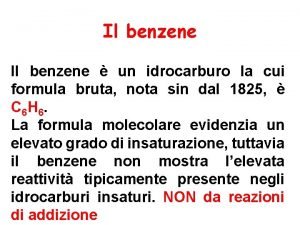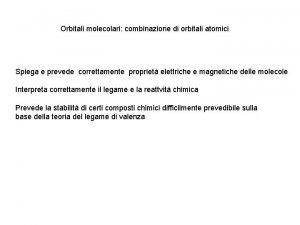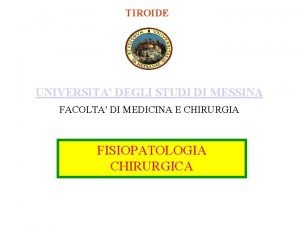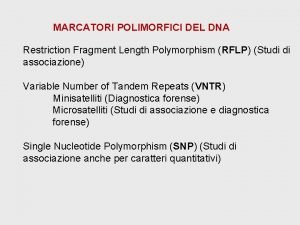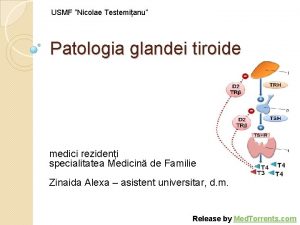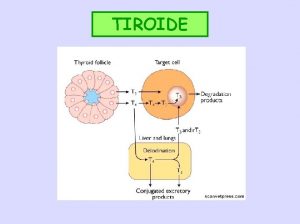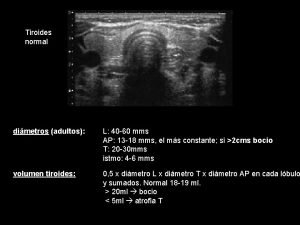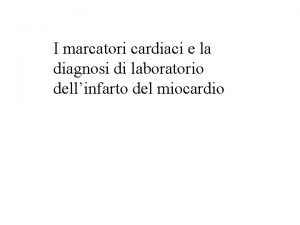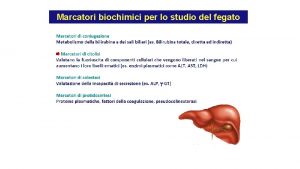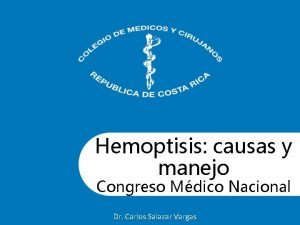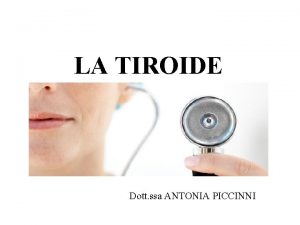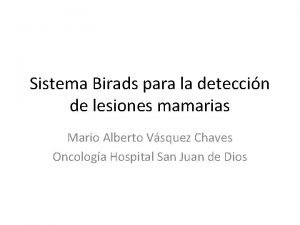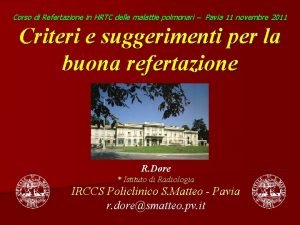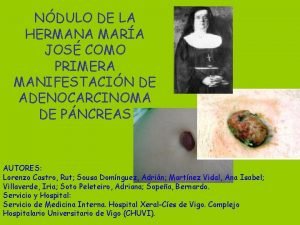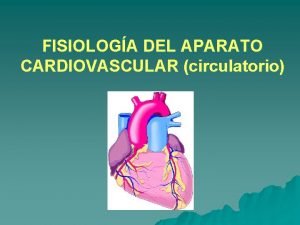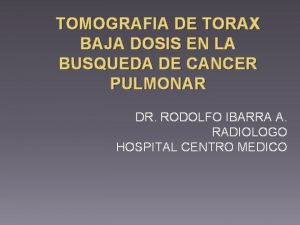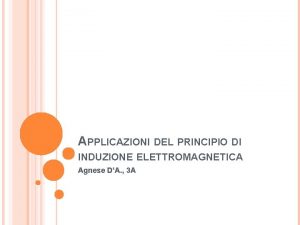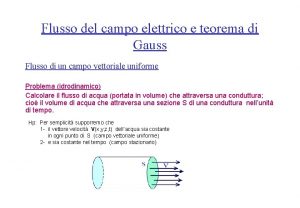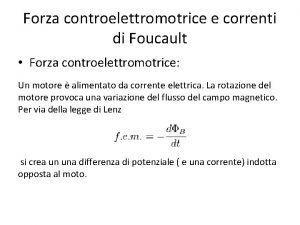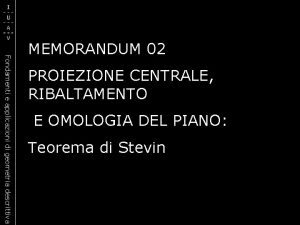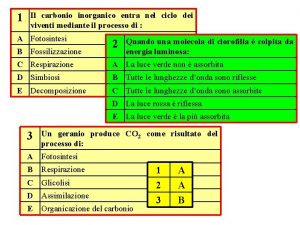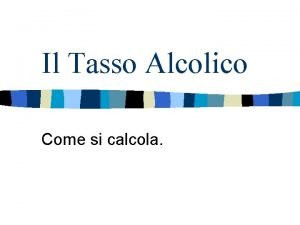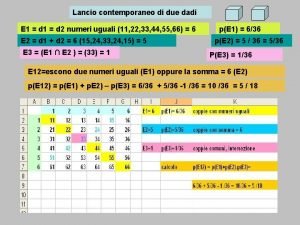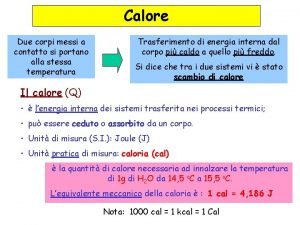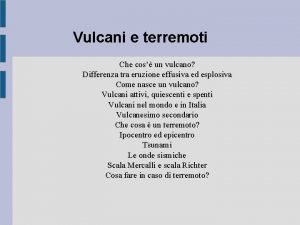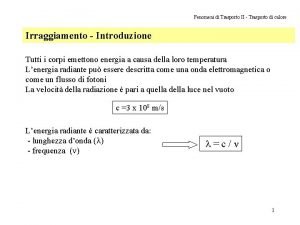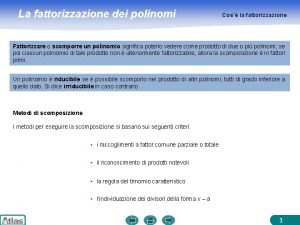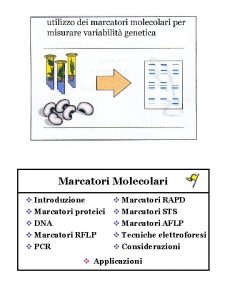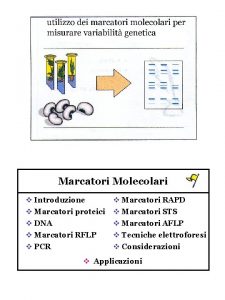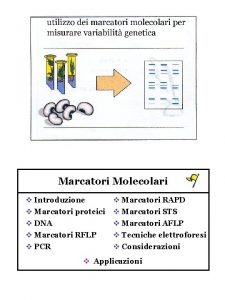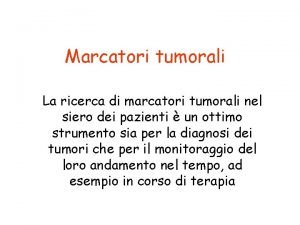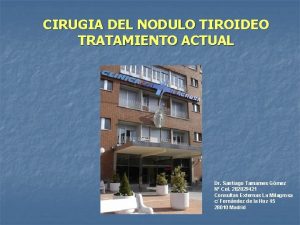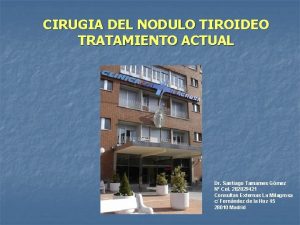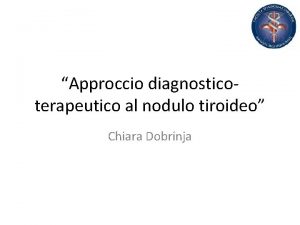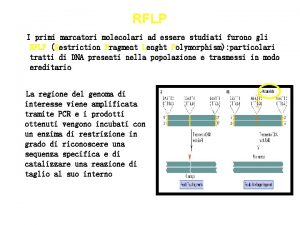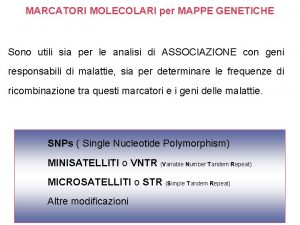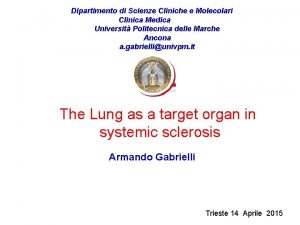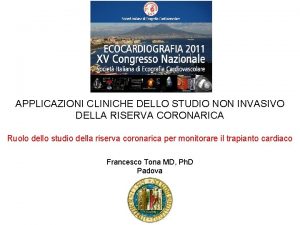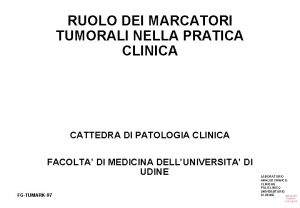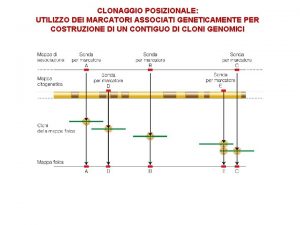Applicazioni cliniche dei marcatori molecolari nel nodulo tiroideo




![BRAF V 600 E point mutation [K 601 E and V 599 Ins] ü BRAF V 600 E point mutation [K 601 E and V 599 Ins] ü](https://slidetodoc.com/presentation_image_h2/048df135489f339c628c84cec14a3f66/image-5.jpg)








































































- Slides: 77

Applicazioni cliniche dei marcatori molecolari nel nodulo tiroideo

Overview of genetic markers Endocrinology Molecular markers

cytology RNA rearrangement studies 15– 20% FNAB inconclusive or unable to discriminate between follicular adenoma and carcinoma DNA somatic mutation analysis need for partial or total thyroidectomy for diagnostic purposes Riesco-Eizaguirre et al. Clin Transl Oncol 2007, 9: 686 -693

Molecular diagnostics in thyroid nodules Riesco-Eizaguirre et al. Clin Transl Oncol 2007, 9: 686 -693 EFE 2015
![BRAF V 600 E point mutation K 601 E and V 599 Ins ü BRAF V 600 E point mutation [K 601 E and V 599 Ins] ü](https://slidetodoc.com/presentation_image_h2/048df135489f339c628c84cec14a3f66/image-5.jpg)
BRAF V 600 E point mutation [K 601 E and V 599 Ins] ü 45 -80% of PTC, mainly tall cell and classic hystology ü extrathyroidal invasion ü higher stage ü recurrence (with reduced I up-take) Lupi et al. J Clin Endocrinol Metab. 2007; 92: 4085 ü de-differentiation DNA resticted to PTC Nikiforova et al. Exp Rev Mol Diagn 2008, 8: 83

FOLLICULAR CARCINOMA PPARg/PAX 8 ? RAS ü 30% FA and 45% of FTC ü large tumor size ü distant metastases PI 3 KCa PTEN AKT FTC initiation DNA NRAS and HRAS mutations ü de-differentiation and poor prognosis Not specific ! Nikiforova et al. Exp Rev Mol Diagn 2008, 8: 83

FOLLICULAR CARCINOMA NRAS and HRAS mutations + Follicular adenoma prophylactic surgery? Follicular carcinoma Improved diagnostic accuracy in samples with negative or insufficient cytology Nikiforova et al. Mod Pathol 2004, 17 (suppl. 1): 77 A

PAPILLARY CARCINOMA NRAS, HRAS or KRAS point mutations ü 15 -20% of PTC, mainly follicular variant ü encapsulation ü lymph node metastases Adeniran et al. Am J Surg Pathol 2006, 30: 216 ü also found in benign lesions Nikiforova et al. Exp Rev Mol Diagn 2008, 8: 83 DNA

PAPILLARY CARCINOMA RET/PTC 1 and RET/PTC 3 paracentric inversions ü 20% of PTC, mainly classical histology ü younger age ü radiation exposure ü lymph node metastases ü lower stage (micro) ü found in adenomas and benign lesions RNA! Nikiforova et al. Exp Rev Mol Diagn 2008, 8: 83

RET/PTC rearrangement Found in 62% of HT Sheils OM et al. Int J Surg Pathol 2000 , 8: 185– 189 Wirtschafter A et al. Laryngoscope 1997, 107: 95– 100 Rhoden KJ et al. J Clin Endocrinol Metab 2006, 91: 2414– 2423 occult neoplasm ? Bias! technical limitations high false positive results lack of reproducibility

FOLLICULAR CARCINOMA PPARg/PAX 8 rearrangement PPARg/PAX 8 ? RAS ü 45% of FTC ü younger age PI 3 KCa ü small tumor size PTEN AKT FTC initiation RNA! t(2; 3) (q 13; p 25) ü vascular invasion Also found in follicular adenomas and in Hurtle cell carcinomas Nikiforova et al. Exp Rev Mol Diagn 2008, 8: 83


“Our results propose a reclassification of thyroid cancers into molecular subtypes that better reflect their underlying signaling and differentiation properties, which has the potential to improve their pathological classification and better inform the management of the disease”

BRAFV 600 E molecular test somatic mutation analysis pyrosequencing MASA RFLP Kim et al. J Clin Endocrinol Metab, 2011, 96: 658 Pelizzo et al. Clin Chem Lab Med. 2011; 49: 325 Zatelli et al. Eur J Endocrinol 2009, 161: 467 direct sequencing allelic discrimination Zatelli et al. Eur J Endocrinol 2009, 161: 467 Rossi et al. J Clin Endocrinol Metab 2012; 97: 2354 specific colorimetric mutation detection assay (Mutector; Trim. Gen, Sparks, MD) Xing et al. J Clin Oncol. 2009; 27: 2977 -82 Affordable costs Dedicated instruments Experienced personnel

Diagnostic importance? Endocrinology Relevant!!

BRAFV 600 E molecular test Cytology BRAF Cytology + BRAF Sensitivity 100 77. 3 89. 6 64. 0 89. 6 86. 7 Specificity 36. 4 98. 8 95. 5 100 95. 5 98. 8 PPV 92. 9 92. 1 99. 4 100 99. 4 92. 9 NPV 100 95. 9 52. 5 93. 7 52. 5 97. 5 Accuracy 93. 3 95. 4 90. 2 96. 9 K value 0. 51± 0. 11 0. 81± 0. 02 0. 63± 0. 07 0. 76± 0. 05 0. 63± 0. 07 Kim et al. J Clin Endocrinol Metab, 2011, 96: 658 0. 88± 0. 01 Zatelli et al. Eur J Endocrinol 2009, 161: 467

Number of clinical/US findings suspected for malignancy in nodules diagnosed as cancer at histology None 4 < 1 cm 3 > 1 cm 1 One 59 < 1 cm 41 > 1 cm 18 Two 79 < 1 cm 62 > 1 cm 17 More than two 91 < 1 cm 34 > 1 cm 57 Even nodules lacking clinical/US findings suspected for malignancy may underlie a thyroid cancer!!! None of the clinical/US findings suspected for malignancy predict BRAF status Rossi …. Zatelii JCEM 2012; 97: 2354

BRAFV 600 E molecular test Cytology + BRAF S NS Sensitivity 76, 8 69, 4 56, 6 51 92, 9 84, 7 Specificity 99, 7 99, 9 100 99, 7 99, 9 PPV 97, 7 98, 6 100 98, 1 98, 8 NPV 96, 5 98 93, 6 96, 9 98, 9 99 Accuracy 96, 6 98, 1 94, 1 97 98, 8 99 BRAF testing significantly increases FNAB sensitivity also in nodules clinically non suspected 15 PTC patients “rescued” by BRAF analysis Rossi …. Zatelii JCEM 2012; 97: 2354

Cancer prevalence nodules >1 cm nodules <1 cm 140 micro. PTC 7. 2% 12. 2% p<0. 001 Rossi …. Zatelii JCEM 2012; 97: 2354 13 multifocal 17 with lymphnode metastases

BRAFV 600 E molecular test S % NS % ACUS 26 3, 1 78 4, 9 PTC 6 75, 0 10 37, 0 BRAF + 5 19, 2 0 0, 0 FN 35 4, 2 62 1, 2 PTC 5 25, 0 9 23, 7 BRAF + 2 5, 7 6 9, 7 BRAF testing identifies as malignant 10% of FN Indication to total thyroidectomy Rossi …. Zatelii JCEM 2012; 97: 2354

Frequencies of genetic alterations according to BSTRC classes Genetic alteration (n) BRAF V 600 E BRAF and RET/PTC 1 BRAF and RET/PTC 3 RAS and RET/PTC 3 RET/PTC-1 RET/PTC-3 RET/PTC-1 and -3 Total samples with genetic alteration(s) None All samples Genetic alteration frequence (%) BRAF V 600 E RAS RET/PTC-1 and RET/PTC-3 Total (s) BSTRC classes I II IV V VI Total 4 0 0 1 0 2 4 0 11 22 33 3 0 0 21 1 25 19 0 69 699 768 7 2 0 4 0 3 3 0 19 33 52 4 0 0 2 0 0 1 0 7 30 37 6 1 1 1 0 11 11 22 10 1 1 2 0 1 17 11 28 34 4 2 31 1 32 29 1 134 806 940 12. 1 3 18. 2 33. 3 0. 4 2. 8 5. 8 9 17. 3 7. 7 15. 4 36. 5 10. 8 5. 4 2. 7 18. 9 36. 3 4. 5 18. 2 50. 0 42. 8 7. 1 17. 8 60. 7 4. 2 3. 4 7. 3 14. 2 RAS mutations and RET/PTC rearrangements are present in benign lesions

Diagnostic value of cytology + genetic analyses Cytology combined with BRAF RAS RET/PTC All genetic analyses PPV 100 76, 3 61, 1 66, 7 NPV 72, 6 45, 6 38, 1 51, 9 sensitivity 76, 4 40, 3 45, 8 82, 2 specificity 100 80 53, 3 31, 8 accuracy 85, 5 55, 6 48, 7 63, 2 BRAF alone is sufficient to detect malignant lesions Rossi …. Zatelii Thyroid. 2015; 25: 221 -8

Cancer risk in thyroid nodules with indeterminate cytology according to Bethesda classification and genetic alteration Indeterminate Class III Class IV Class V (n°=52*) (n°=37) (n°=22) Cytology alone 19. 2% 21, 6% 90, 9% 27, 1 % Any mutation 47, 3% 71, 4% 90, 9% 63, 1% BRAF 100% RAS 0% 50% 0% 14, 2% RET/PTC-1 40% - 100%* 57, 1% RET/PTC-3 0% 0% 100%* 33, 3% No mutations 3% 10% 90, 9% 13, 5% N° (%) Rossi …. Zatelii Thyroid. 2015; 25: 221 -8 cytology (n°=111)

PTC distribution according to TNM stages and the presence/absence of a genetic alteration Thyroid cancers TNM staging Genetic alteration Total (AJCC/UICC ) positive negative I 28 19 47 II 0 0 0 III 13 6 19 IV 6 0 6 Total 47 25 72 Rossi …. Zatelii Thyroid. 2015; 25: 221 -8

CONCLUSION -1 BRAF molecular analysis increases diagnostic sensitivity of cytology for PTC

Prognostic relevance? Endocrinology Not so sure…

PAPILLARY CARCINOMA BRAF mutation(s) + - NIS expression + DNA synthesis and apoptosis NIS trafficking to the membrane Riesco-Eizaguirre et al. Endocrine-Related Cancer 2006, 13: 257 little growth advantage MMP, vimentin, osteopontin epithelial-mesenchimal transition Vasko et al. Curr Opin Oncol 2007; 19: 11 BUT genomic instability Mitsutake et al. Cancer Research 2005; 65: 2465

Xing et al. J Clin Oncol. 2009; 27: 2977 -82

BRAFV 600 E molecular test significantly reduced disease-free probability in BRAF+ patients Xing et al. J Clin Oncol. 2009; 27: 2977 -82

BRAFV 600 E molecular test significantly increased mortality in BRAF+ patients Elisei et al. J Clin Endocrinol Metab. 2008; 93: 3943

1849 patients Greater mortality in BRAF+ (5. 3%) vs BRAF- (1. 1%) patients

“When lymph node metastasis, extrathyroidal invasion, and distant metastasis were also included in the model, the association of BRAF V 600 E with mortality for all PTC was no longer significant”

156 PTC Prospective study 80 BRAF V 600 E + PTC 76 BRAF V 600 E - PTC 40 N 1 40 N 0 36 N 1 40 N 0 Case-control study, matching for risk factors such as : 1. 2. 3. 4. gender age hystotype disease stage

At 6 -8 months RAI treated Followup At 2 yr Last follow-up Not RAI treated Evaluations: Ø basal Tg levels Ø rh. TSH-stimulated Tg Ø neck US Ø I 131 Total body scan follow-up: 2 to 6 years Last follow-up 1. COMPLETE RESPONSE 2. LOCOREGIONAL DISEASE 3. BIOCHEMICAL PESISTENCE

PATIENTS SUBMITTED TO RAI 100 90 80 70 % 60 50 40 30 20 10 0 complete response rates BRAF+ N 1 BRAF+ N 0 BRAF- N 1 BRAF- N 0 6 -8 months 2 yr last follow-up complete response rates do not depend on BRAF mutation no impact on prognosis

CONCLUSION -2 BRAF status may not predict patients outcome

BRAFV 600 E molecular test PTC persistence/recurrence prediction All PTC Conventional PTC sensitivity 68% 79% specificity 66% 60% PPV 36% 34% NPV 88% 92% Xing et al. J Clin Oncol 2009; 27: 2977 -82 BRAF mutation–positive patients are significantly more likely to have PTC persistence/recurrence

PTC distribution according to TNM stages and the presence/absence of a genetic alteration Thyroid cancers TNM staging Genetic alteration Total (AJCC/UICC ) positive negative I 28 19 47 II 0 0 0 III 13 6 19 IV 6 0 6 Total 47 25 72 Rossi …. Zatelii submitted

BRAFV 600 E molecular test significantly reduced disease-free probability in BRAF+ patients Xing et al. J Clin Oncol. 2009; 27: 2977 -82

BRAFV 600 E molecular test significantly increased mortality in BRAF+ patients Elisei et al. J Clin Endocrinol Metab. 2008; 93: 3943

1849 patients Greater mortality in BRAF+ (5. 3%) vs BRAF- (1. 1%) patients

“When lymph node metastasis, extrathyroidal invasion, and distant metastasis were also included in the model, the association of BRAF V 600 E with mortality for all PTC was no longer significant”

A higher BRAF V 600 E–associated patient mortality was observed in several clinicopathological subcategories, but statistical significance was lost with adjustment for patient age, sex, and medical center.

Integrazione citologica e molecolare Genomic mutations BRAF V 600 E point mutation Follow-up RAI (126 patients) staging + RAI re-staging diagnosis T 0 (months) 3 no RAI staging (34 patients) 3 9 1 st follow-up 2 nd follow-up (126 patients) (121 patients) 21 39 up to 10 years 1 st follow-up 2 nd follow-up (31 patients) (28 patients) NO difference between BRAF+ and BRAF- PTCs Damiani et al. Eur Thyroid J 2018, in press EFE 2018

Osservazione dello stato di malattia all’ultimo controllo di follow-up per o pazienti e confronto con il corrispondente a 6 mesi, per valutare eventua Pazienti stabili Pazienti migliorati Pazienti peggiorati

Risultati: confronto tra i gruppi BRAFV 600 E+ e BRAFV 600 E • Genere GENERE BRAFV 600 E - BRAFV 600 E+ TOTALE F, n (%) 112 (71, 34) 168 (69. 14) M, n (%) 30 (34, 88) 45 (28, 66) 75 (30, 86) TOTALE 86 157 243 56 (65, 12)

Risultati: confronto tra i gruppi BRAFV 600 E+ e BRAFV 600 El. Età BRAFV 600 E ETA’ MEDIA 0 51, 14 ± 15, 22 1 49, 68 ± 15, 58

Risultati: confronto tra i gruppi BRAFV 600 E+ e BRAFV 600 El. Stadio STADIO BRAFV 600 E+ BRAFV 600 E- Totale I II IV Totale 140 (89, 2%) 15 (9, 6 %) 1 (0, 6%) 157 77 (89, 5%) 8 (9, 30%) 1 (1, 2%) 0 86 217 23 2 1 243

Risultati: associazione tra BRAFV 600 E e stato di malattia

Risultati: associazione tra BRAFV 600 E e stato di malattia

Risultati: variazione dello stato di malattia

Risultati: analisi delle sopravvivenza per outcome - peggioramento BRA F V 600 E BR AF

Risultati: analisi delle sopravvivenza per outcome - peggioramento

Discussione dei risultati BRAFV 600 E non ha mostrato un valore progno caratteristiche clinico-patologiche della nostra popolazione: • PTC a basso rischio di recidiva • trattamento precoce con tiroidectomia totale e terapia radio Ottima prognosi

CONCLUSION -2 BRAF status may NOT predict patients outcome

What about therapy? Endocrinology Well…

100% 80% 60% NO RAI 40% 20% 0% BRAF+ N 1 BRAF+ N 0 BRAF- N 1 BRAF- N 0 BRAF mutation did not influence the indication for radiometabolic therapy

Thyroid cancer in Ferrara Years Patients number I 131 therapy (no) % I 131 therapy/ thyroid cancer pre-BRAF 2000 -2006 467 402 86, 08% post-BRAF 2007 -2013 738 524 71, 00% ↑ 36. 7% in DTC diagnosis (+39 new cases/year) > 50% stage I and II

PTC distribution according to TNM stages and the presence/absence of a genetic alteration Thyroid cancers TNM staging Genetic alteration Total (AJCC/UICC ) positive negative I 28 19 47 II 0 0 0 III 13 6 19 IV 6 0 6 Total 47 25 72 Rossi …. Zatelii Thyroid. 2015; 25: 221 -8

Thyroid cancer in Ferrara Years Patients number I 131 therapy (no) % I 131 therapy/ thyroid cancer pre-BRAF 2000 -2006 467 402 86, 08% post-BRAF 2007 -2013 738 524 71, 00% ↑ 36. 7% in DTC diagnosis (+39 new cases/year) > 50% stage I and II

BRAFV 600 E molecular test May address patients with persistent/recurrent disease to therapy with BRAF-specific inhibitors Cantwell-Dorris et al. Mol Cancer Ther 2011, 10: 385

CONCLUSION -3 BRAF V 600 E may influence therapeutic approach

• any surgical relevance ?

Ricercare caratteristiche cliniche, ecografiche e molecolari che possono predire un incremento del rischio di bilateralità della malattia, in soggetti a cui è stata fatta diagnosi di PTC e modulare, di conseguenza, l’approccio chirurgico. I parametri valutati sono: • Status di BRAF (ponendo attenzione soprattutto sulla mutazione somatica V 600 E) • Parametri ecografici • Familiarità • Coesistenza di tiroidite • Dimensioni ecografiche del nodulo > 1 cm

PAZIENTI, MATERIALI E METODI Pazienti Il database su cui è stato svolto il lavoro è il registro degli agoaspirati dell’Unità Operativa di Endocrinologia di Ferrara che contiene i dati di 11946 pazienti. All’interno del database sono stati selezionati i pazienti a cui è stata fatta diagnosi di PTC. Ogni paziente affetto da PTC possiede almeno un nodulo tiroideo e ciascun nodulo tiroideo può possedere diverse caratteristiche ecografiche. Il numero totale di analisi ecografiche e citologiche è 861.

PAZIENTI, MATERIALI E METODI Caratteristiche anamnestiche e molecolari Totale Pz. con PTC bilaterale Pz. con PTC unilaterale Numero pz= 703 180 523 Familiarità= 51 15 36 Tiroidite= 166 42 124 BRAF V 600 E+= 448 131 317 Principali caratteristiche ecografiche e dimensioni del nodulo Totale Pz. con PTC bilaterale Pz. con PTC unilaterale Numero analisi= 861 236 625 Noduli ipoecogeni 151 391 Noduli isoecogeni 51 162 Noduli calcifici 103 241 Dimensioni > 1 cm= 348 92 256

RISULTATI Età media e sesso Età media M F F/M PTC totali 52 172 531 3: 1 PTC bilaterali 52 50 130 2, 6: 1 PTC unilaterali 52 122 401 3: 1 Età media dei maschi Età media delle femmine Pz. con PTC bilaterale 54 50 Pz. con PTC unilaterale 54 51

RISULTATI Età media e sesso Test chi-quadro Maschi Femmine Pz. con PTC bilaterale 50 130 Pz. con PTC unilaterale 122 401 Applicato il test del chi-quadro si osserva p-value=0, 2308, p > 0, 05. Risultato non statisticamente significativo. Dai dati emersi, il parametro sesso non rappresenta un fattore predittivo di bilateralità per il PTC.

RISULTATI Familiarità Test chi-quadro Familiarità positivi Familiarità negativi Pz. con PTC bilaterale 15 165 Pz. con PTC unilaterale 36 487 Applicato il test del chi-quadro si osserva p-value=0, 5177, p > 0, 05. Tiroidite Test chi-quadro Tiroidite positivi Tiroidite negativi Pz. con PTC bilaterale 42 138 Pz. con PTC unilaterale 124 399 Applicato il test del chi-quadro si osserva p-value=0, 9183, p > 0, 05. Risultati non statisticamente significativi. Dai dati emersi, i parametri familiarità e tiroidite non rappresentano dei fattori predittivi di bilateralità per il PTC.

RISULTATI Status di BRAF Test-chi quadro BRAF V 600 E positivi BRAF V 600 E negativi Pz. con PTC bilaterale 131 49 Pz. con PTC unilaterale 317 206 448 255 Totali Applicato il test del chi-quadro si osserva, p-value=0, 0034, p < 0, 05. Risultato statisticamente significativo. Dai dati emersi, la positività per la mutazione somatica di BRAF V 600 E rappresenta un fattore predittivo di bilateralità per il PTC.

RISULTATI Status di BRAF Test-chi quadro BRAF V 600 E positivi BRAF V 600 E negativi Pz. con PTC bilaterale 131 49 Pz. con PTC unilaterale 317 206 448 255 Totali • Il 72 % dei pz. con PTC bilaterale porta la mutazione. • Il 60% dei pz. con PTC unilaterale porta la mutazione. • Il 29% dei pazienti affetti che portano la mutazione somatica di BRAF V 600 E ha sviluppato un PTC bilaterale. • Il 19% dei pazienti affetti che non sono portatori della mutazione somatica di BRAF V 600 E ha sviluppato un PTC bilaterale.

RISULTATI Ipoecogenicità Test chi-quadro Noduli ipoecogeni Noduli non ipoecogeni Pz. con PTC bilaterale 151 85 Pz. con PTC unilaterale 391 234 Applicato il test del chi-quadro si osserva p-value=0, 6997, p > 0, 05. Isoecogenicità Test chi-quadro Noduli isoecogeni Noduli non isoecogeni Pz. con PTC bilaterale 51 185 Pz. con PTC unilaterale 162 463 Applicato il test del chi-quadro si osserva p-value=0, 1911, p > 0, 05. Risultati non statisticamente significativi. Dai dati emersi, i parametri “ipoecogenicità” e “isoecogenicità” non rappresentano dei fattori predittivi di bilateralità per il PTC.

RISULTATI Calcificazioni del nodulo Test chi-quadro Noduli calcifici Noduli non calcifici Pz. con PTC bilaterale 103 133 Pz. con PTC unilaterale 241 384 Applicato il test del chi-quadro si osserva p-value=0, 1742, p > 0, 05. Dimensioni ecografiche del nodulo Test chi-quadro Noduli > 1 cm Noduli < 1 cm Pz. con PTC bilaterale 92 144 Pz. con PTC unilaterale 256 369 Applicato il test del chi-quadro si osserva p-value=0, 5979, p > 0, 05. Risultati non statisticamente significativi. Dai dati emersi, il parametro “calcificazioni del nodulo” e le dimensioni del/i nodulo/i non rappresentano un fattore predittivo di bilateralità per il PTC.

CONCLUSIONI La letteratura e le ultime linee guida ATA del 2015 indicano che la scelta chirurgica deve ricadere su: • Tiroidectomia totale nel momento in cui viene diagnosticato un nodulo neoplastico maligno con diametro superiore ai 4 cm. • Tiroidectomia o lobectomia nei noduli di dimensioni comprese tra 1 cm e 4 cm. • Lobectomia per i noduli neoplastici di dimensioni inferiori ad 1 cm. Il clinico si trova in una posizione controversa, in cui la scelta chirurgica potrebbe portare il paziente, da un lato, all’overtreatment (tiroidectomia totale), dall’altro ad un inadeguato trattamento del PTC (lobectomia). I risultati del nostro studio mettono in luce che conoscere lo status mutazionale di BRAF può contribuire a modulare ed adattare a ciascun paziente il miglior approccio chirurgico.

CONCLUSIONI Il riscontro della mutazione somatica di BRAF può essere d’aiuto al clinico nella scelta chirurgica più appropriata, secondo quanto indicato nell’algoritmo che proponiamo, migliorando, di conseguenza, la gestione e l’outcome del paziente.

CONCLUSION -3 BRAF V 600 E may influence surgical approach

THEREFORE BRAFV 600 E molecular test FNAB material ü increases cytology diagnostic sensitivity for PTC ü may predict patients outcome ü influences surgical approach ü allows detection of minimal disease metastatic to cervical lymph nodes Xing et al. 2004 J Clin Endocrinol Metab 89: 2867 Cohen et al. 2004 Clin Cancer Res 10: 2761 Domingues et al. 2005 Cytopathology 16: 27 Zatelli et al 2009 J Clin Endocrinol Metab Nikiforov et al. 2009 J Clin Endocrinol Metab 94: 2092 Rossi et al 2012 Clin Endocrinol Metab Kim et al. 2006 Ann Surg 244: 799 Kim et al. 2006 Clin Endocrinol 65: 364 Xing 2007 Endocr Rev 28: 742 Nikiforova et al 2008 Expert Rev Mol Diagn 8: 83 Riesco-Eizaguirre et al. 2006. Endocr Rel Cancer 13: 257 Xing et al. 2005 J Clin Endocrinol Metab 90: 6373 Mojica et al 2006 Endocr Pathol 17: 183
 Nodulo tiroideo
Nodulo tiroideo Formula bruta benzene
Formula bruta benzene Orbitali molecolari
Orbitali molecolari Struma adenomatoso
Struma adenomatoso Rflp polimorfismo
Rflp polimorfismo Tireotoxicoza cu gusa difuza
Tireotoxicoza cu gusa difuza Marcatori polimorfici
Marcatori polimorfici Deiodazione
Deiodazione Dimetros
Dimetros Marcatori cardiaci
Marcatori cardiaci Marcatori epatici
Marcatori epatici Regioni del collo
Regioni del collo Ley de frank starling del corazon
Ley de frank starling del corazon Nodulo cavitado pulmonar
Nodulo cavitado pulmonar Anatomia glandei tiroide
Anatomia glandei tiroide Birads 2
Birads 2 Nodulo de busacca
Nodulo de busacca Nodulo fibrocalcifico
Nodulo fibrocalcifico Nodulo silicotico
Nodulo silicotico Nodulo de la hermana maria jose
Nodulo de la hermana maria jose Nodulo sinusal
Nodulo sinusal Nodulo benigno
Nodulo benigno Site:slidetodoc.com
Site:slidetodoc.com Induzione elettromagnetica applicazioni
Induzione elettromagnetica applicazioni Diodi ideali
Diodi ideali Applicazioni intelligenza artificiale in medicina
Applicazioni intelligenza artificiale in medicina Induzione elettromagnetica applicazioni
Induzione elettromagnetica applicazioni Equazioni differenziali applicazioni economiche
Equazioni differenziali applicazioni economiche Applicazioni del teorema di gauss
Applicazioni del teorema di gauss Corrente di foucault
Corrente di foucault Applicazioni integrali alla fisica
Applicazioni integrali alla fisica Tre note
Tre note Applicazioni di geometria descrittiva
Applicazioni di geometria descrittiva Carbonio inorganico entra nel ciclo dei viventi
Carbonio inorganico entra nel ciclo dei viventi Personaggi testo narrativo
Personaggi testo narrativo Analisi del testo narrativo prima superiore
Analisi del testo narrativo prima superiore Parafrasi canto iii inferno
Parafrasi canto iii inferno Apologo sull'onestà nel paese dei corrotti
Apologo sull'onestà nel paese dei corrotti La marcia dei diritti dei bambini canzone
La marcia dei diritti dei bambini canzone Poligono regolare definizione
Poligono regolare definizione Agnus dei qui tollis peccata mundi, miserere nobis
Agnus dei qui tollis peccata mundi, miserere nobis Processi di stregoneria nel medioevo
Processi di stregoneria nel medioevo Idratazione con ipodermoclisi nel paziente anziano
Idratazione con ipodermoclisi nel paziente anziano Costante dielettrica
Costante dielettrica Mappa concettuale nel mare ci sono i coccodrilli
Mappa concettuale nel mare ci sono i coccodrilli Svetonio gesù
Svetonio gesù Formula calcolo tasso alcolemico
Formula calcolo tasso alcolemico Fabliaux testi
Fabliaux testi Nato a milano nel 1785
Nato a milano nel 1785 Monolatrico
Monolatrico śladami stasia i nel mapa
śladami stasia i nel mapa Percorso nel buio milano
Percorso nel buio milano Nel lancio contemporaneo di due dadi quanti elementi
Nel lancio contemporaneo di due dadi quanti elementi Irraggiamento nel vuoto
Irraggiamento nel vuoto Giovanni pascoli e la natura
Giovanni pascoli e la natura Il romanticismo musicale
Il romanticismo musicale Mappa vulcani nel mondo
Mappa vulcani nel mondo Fasi del testo narrativo
Fasi del testo narrativo Dante alighieri nel mezzo del cammin
Dante alighieri nel mezzo del cammin Irraggiamento nel vuoto
Irraggiamento nel vuoto Mappa concettuale sulla retta
Mappa concettuale sulla retta Mentre ch'i rovinava in basso loco parafrasi
Mentre ch'i rovinava in basso loco parafrasi Trinomio
Trinomio Blumara 15 gin
Blumara 15 gin Questione della lingua nel 600
Questione della lingua nel 600 Tipi di sequenze testo narrativo
Tipi di sequenze testo narrativo Frasi periodo ipotetico della realtà
Frasi periodo ipotetico della realtà Ti auguro una felice giornata
Ti auguro una felice giornata Monodia profana
Monodia profana Piano cartesiano pdf zanichelli
Piano cartesiano pdf zanichelli Cos'è una analessi
Cos'è una analessi I moti convettivi del mantello
I moti convettivi del mantello Confronto tra la pioggia nel pineto e piove di montale
Confronto tra la pioggia nel pineto e piove di montale Cosa ti piace fare nel tempo libero
Cosa ti piace fare nel tempo libero Canto rallegratevi nel signore
Canto rallegratevi nel signore Sii il cambiamento che vuoi vedere nel mondo
Sii il cambiamento che vuoi vedere nel mondo Alimentazione nel 700
Alimentazione nel 700 Teatro nel teatro
Teatro nel teatro

